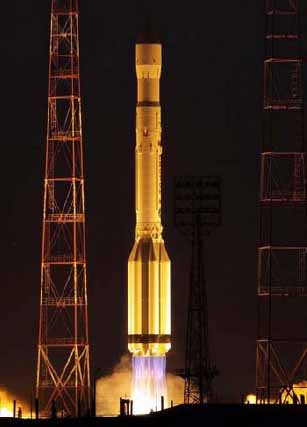 GLONASS Launch on September 2, 2010
GLONASS Launch on September 2, 2010With activation of three modernized GLONASS (GLONASS-M) satellites launched on September 2 and plans to put four more space vehicles (SVs) into orbit before the end of this year, the Russian GNSS system will have more than enough spacecraft for an FOC declaration in the not-too-distant future.
With activation of three modernized GLONASS (GLONASS-M) satellites launched on September 2 and plans to put four more space vehicles (SVs) into orbit before the end of this year, the Russian GNSS system will have more than enough spacecraft for an FOC declaration in the not-too-distant future.
A triple launch of GLONASS-Ms is planned in early December, with the first demonstration flight of the next-generation GLONASS-K expected before the end of the year. The latter spacecraft will transmit the first CDMA signals in addition to the system’s traditional FDMA and is expected to be launched about December 24 or 25 on a Soyuz rocket from the Plesetsk, Russia, launch site rather than on Proton launchers from Baikonur, Kazakhstan.
The constellation currently has 23 operational satellites, two non-functional spares, and another that recently had a navigation payload failure and will be removed from service. About 11 more GLONASS-M satellites will be launched by the end of 2012, according to Sergey Revnivykh of the Russian Federal Space Agency (Roscosmos).
Russian military controllers brought the latest trio of GLONASS-M satellites on-line fairly quickly — between October 4 and 11.
Currently, the system provides 98 percent global coverage with dilution of precision (DOP) of less than 6, assuming a five-degree masking angle. Moreover, system accuracy continues to improve with the modernized space vehicles (SVs) — now producing a 1.8 meter user range error, Revnivykh said. He predicted that GLONASS performance would be comparable with GPS by the end of 2011.
Apparently, several versions of the new GLONASS-K satellites are planned. GLONASS-K1 satellites will have a 10-year design life and clock stability of 5×10-14. Only one more GLONASS-K1 satellite will be built and launched after that.
A new design, GLONASS-K2, will start launching in 2013. The K2 satellites will have a 10-year design life and a clock stability of 1×10-14.
The first CDMA signal will transmit on L3 — a QPSK(10) modulation centered at 1202.025 MHz. — and use truncated Kasami ranging codes. CDMA signals will also be transmitted on L1 and L2. According to a paper presented at the ION GNSS 2010 conference in Portland, Oregon, last month, “intensive studies for developing new CDMA signals” at these frequencies are under way with particular attention being paid to ensure low power spectral density (-238 dBWt/m2·Hz) in radio astronomy band 1610.6–1613.8 MHz.
The GLONASS-K satellites will transmit the legacy FDMA satellites in addition to the CDMA signals.
A modernized GLONASS-K satellite, GLONASS-KM, is now under study, Revnivykh said. In addition to transmitting legacy FDMA signals on L1 and L2 and CDMA signals on L1, L2, and L3, CDMA signals may also be transmitted on the GPS L5 frequency at 1176.45 MHz. If approved and built, the GLONASS-KMs would not launch until after 2015.
The accompanying chart shows Roscosmos’s current plans for introducing new generations of GLONASS satellites and CDMA signals.





